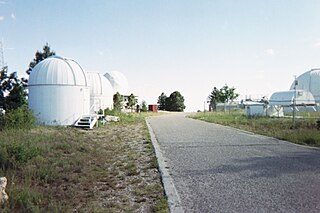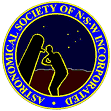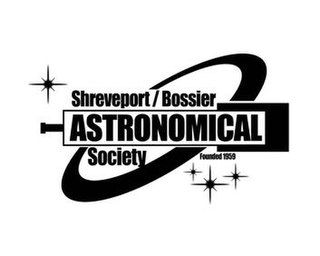
The Stellafane Observatory is an astronomical observatory in Springfield, Vermont, founded in 1920 by Russell W. Porter. The Pink Clubhouse was built in 1923 at the site by the Springfield Telescope Makers Club. The name Stellafane, suggested by Porter at the club's December 1923 meeting, is derived from the Latin words stella and fanum meaning "Shrine to the Stars", and originally referred specifically to the clubhouse, but has since come to refer to all of the club's land and buildings on the summit of Breezy Hill, west of downtown Springfield.

The Institute of Astronomy (IoA) is the largest of the three astronomy departments in the University of Cambridge, and one of the largest astronomy sites in the United Kingdom. Around 180 academics, postdocs, visitors and assistant staff work at the department.
The Fick Observatory was an astronomical observatory owned and operated by Iowa State University. Located southwest of Boone, Iowa, it was named after Davenport, Iowa, amateur astronomer Erwin W. Fick. The observatory closed in 2015.

Mount Laguna Observatory (MLO) is an astronomical observatory owned and operated by San Diego State University (SDSU). The telescope was operated in partnership with the University of Illinois at Urbana-Champaign (UIUC) until 2000. MLO is located approximately 75 kilometers (47 mi) east of downtown San Diego, California (USA) on the eastern edge of the Cleveland National Forest in the Laguna Mountains on the SDSU Astronomy Campus near the hamlet of Mount Laguna. MLO was dedicated on June 19, 1968, seven years after SDSU's Department of Astronomy became an independent academic department of SDSU's College of Sciences. The dedication took place during the 1968 summer meeting of the Astronomical Society of the Pacific. Currently SDSU is working with University of Kansas (KU), and UNC Chapel Hill on various projects.
The Amateur Astronomers Association of Pittsburgh (AAAP) is an Astronomical Organization founded on June 9, 1929, by Chester B. Roe and Leo J. Scanlon. Since establishment, it has grown to over 500 members and operates two observatories in the Pittsburgh region: the Nicholas E. Wagman Observatory and the Mingo Creek Park Observatory. The club also sponsors many star parties which are open to members of the public throughout the year.

Chamberlin Observatory is an astronomical observatory owned and operated by the University of Denver. It is located in Denver, Colorado (US) in Observatory Park. It is named for Humphrey B. Chamberlin, a Denver real estate magnate who pledged $50,000 in 1888 to build and equip the facility.
The William G. and Retha Stone Baker Observatory is an astronomical observatory owned and operated by Missouri State University. It is located in Marshfield, Missouri.

Mount Lemmon Observatory (MLO), also known as the Mount Lemmon Infrared Observatory, is an astronomical observatory located on Mount Lemmon in the Santa Catalina Mountains approximately 28 kilometers (17 mi) northeast of Tucson, Arizona (US). The site in the Coronado National Forest is used with special permission from the U.S. Forest Service by the University of Arizona's Steward Observatory, and contains a number of independently managed telescopes.

Mills Observatory is the first purpose-built public astronomical observatory in the UK, located in Dundee, Scotland. Built in 1935, the observatory is classically styled in sandstone and has a distinctive 7 m dome, which houses a Victorian refracting telescope, a small planetarium, and display areas. The dome is one of two made from papier-mâché to survive in the UK, the other being at the Godlee Observatory.

Edward A. Halbach was an American amateur astronomer and prolific variable star observer.

J A Jones Hoober Observatory is a privately owned observatory located in South Yorkshire, England near to the villages of Hoober and Wentworth, 4 miles (6.4 km) North-northwest of Rotherham. It can be found about 300 metres (0.19 mi) east of Hoober Stand. The observatory is owned and operated by Mexborough & Swinton Astronomical Society (NPO).

Powell Observatory is an astronomical observatory located near Louisburg in Miami County, Kansas. It features several large telescopes and is available for public viewing, for private use of Astronomical Society of Kansas City members, and for ongoing research projects.
The Hector J. Robinson Observatory, located in Lincoln Park, Michigan, is an Astronomical Observatory that features a 14-inch Celestron SCT telescope. Following renovation, the observatory resumed operations in September 2009, with First light ceremonies taking place early that September.

Catalina Station (CS), also known as Steward Observatory Catalina Station, is an astronomical observing facility located on Mount Bigelow in the Santa Catalina Mountains approximately 29 kilometers (18 mi) northeast of Tucson, Arizona. The site in the Coronado National Forest is used with special permission from the United States Forest Service by the Steward Observatory of the University of Arizona.

The Astronomical Society of New South Wales (ASNSW) is an amateur astronomy club in the state of New South Wales, Australia. Founded in 1954, the society currently has over 400 members.

The Astronomical Society of Victoria (ASV) is an amateur astronomy club in the state of Victoria, Australia. It was founded in 1922, making it one of the oldest such clubs in the country, and with some 1500 members it claims to be one of the largest amateur astronomy organisations in the southern hemisphere. Membership is open to all with an interest in astronomy, and the society caters for people with a wide range of ages, backgrounds, abilities and interests.
Sheep Hill Observatory is an Astronomical observatory located in Morris County, New Jersey. It features an 18-inch (457mm) Newtonian reflecting telescope and is open to the public on the 3rd Friday evening of each month, weather permitting. It is also made available to Schools, Scouting Groups and other educational groups upon request.

The Shreveport-Bossier Astronomical Society, Inc. is a 501(c)(3) tax-exempt organization and one of the oldest continuously meeting astronomy clubs in the United States of America. Originally named the Shreveport Junior Astronomical Society, it was founded in 1959 by a group of high school students led by a fellow student, Sara Worley. Fifteen people attended an organizational meeting to establish a club on October 10, 1959. Officers were elected at this meeting and Sara Worley became the first president of the Shreveport Junior Astronomical Society. A second organizational meeting took place on October 17, 1959, where a constitution and additional society-related details were established. The constitution was approved, signed, and ratified at a third meeting on October 24, 1959, although there was no State of Louisiana charter. The first public meeting of the club was held on November 14, 1959 at Centenary College of Louisiana. Two goals were announced: build an observatory and procure a planetarium for the Shreveport area. Within five years, these two goals were accomplished through local participation and fundraising.
The Astronomy Centre, also known as the Amateur Astronomy Centre, is an astronomical observatory located in northern England which is run by experienced amateur astronomers and is open to the public at certain times.

The Hampstead Scientific Society (HSS) in north London was founded in July 1899 as the Hampstead Astronomical and General Scientific Society by P.E. Vizard. It aims to be inclusive, promoting and nurturing an interest in all branches of science, while catering for wide levels of knowledge, from layman to expert alike. The society maintains specialist astronomy and meteorology sections and runs a programme of lectures on various scientific topics in the Hampstead area of North West London.
















